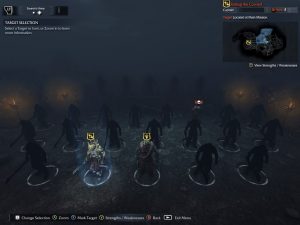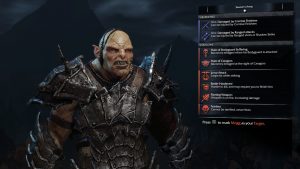When it was announced that there would be a new Lord of the Rings-styled game, it was easy to see the developers coping the Batman and Assassin’s Creed series. Games based on LoTR have varied in quality, and signs were pointing to this being another flop. While Shadows of Mordor doesn’t hit the same heights as other open world games, it’s still one of the best games based on the LoTR property.
Ringing:
You play as a ranger whose family is killed by Sauron’s elite group: The Black Hand, before his arrival in the Fellowship of the Ring. Just before dying, you are bound to a former ringwraith who wants to take revenge on Sauron and his followers.
What follows is your standard open-world game of completing missions, finding lots of collectibles and growing from a bad-ass to death incarnate. You can use stealth and ranged-based attacks to thin numbers before engaging in melee. The majority of the time in Shadows of Mordor will be spent fighting Uruks. The enemy types fall into a few categories, as their numbers are the main threat.
If that was all there was to Shadows of Mordor, the game would have been an above-average open world game, but there’s one element that really helps to elevate the game.
The Chain of Command:
Shadows of Mordor’s Nemesis system is the high point of the game and a brilliant game mechanic. As you explore the game’s two areas, you’ll be able to see the army structure of Sauron. Sauron’s army is split between the grunts that you kill in the field, captains that manage them, and war chiefs who are at the top. As you play, your actions and inactions will affect how Sauron’s army is organized.
Captains will fight each other for higher positioning and to maybe rise up to war chief. The amazing part is how the game essentially procedurally generates these conflicts and situations.
Each commanding uruk has different traits that are given to them. These traits ranged from weaknesses you can exploit, to strengths that make them harder to fight.
Once you unlock the ability to control or “bound” uruks, the system takes on a whole new meaning. You can take over captains and help them rise in power while serving you.
Part of the fun of the game is setting up Game of Thrones-esque betrayals and power struggles to serve your needs. Killing the higher ranked uruks will give you passive runes that can be slotted to enhance your abilities.
You’ll need to make use of the nemesis system, as new skills are locked behind power struggle experience. The game does a good job of integrating all these systems into your options on the field.
Some enemies can be killed with nothing more than an arrow to the head or a stealth attack. Stronger enemies will require you to prepare suitable traps or get help from your bound captains to take out. There’s something amazing about setting up a multi-stage plan to take out a war chief and replace him with one of your own.
The Nemesis system quite frankly is the best part of Shadows of Mordor and something other developers should take note of. Unfortunately, like other open-world styled games, Shadows of Mordor can’t escape the usual suspects of problems.
A Long Journey:
Shadows of Mordor hits all the right and wrong notes of recent open-world inspired games. The balance of the game never feels completely right. You’ll find yourself either struggling or completely dominating depending on how much time you spend unlocking abilities.
Once you hit that point of domination, the game starts to lose its challenge. The enemy designs don’t change all that much from beginning to end, and nothing gets introduced as a fight on your level. By the half way point, you’ll be teleporting across large distances to kill enemies, causing explosions and even unlocking super abilities.
The story missions don’t do anything unique or different to the gameplay, and are all based on: Go here and either collect something, protect something or kill someone. There are a few boss fights in the game, but again, nothing that will match you in terms of power.
The Nemesis system, while amazing, does have its limitations. Once you have bound uruks as war chiefs, you can pretty much stop paying attention. If there’s a sequel, I would love for them to focus more on the Nemesis system and make it a bigger part of the game instead of story missions.
The main problem with Shadows of Mordor is that the moment-to-moment gameplay can become repetitive.
Eventually, I got tired of hunting for collectibles and side-quests, as there was no point to becoming even more powerful than I was.
One part that I did like about Mad Max was how upgrades were tied to the side quests and your abilities and car grew in power as you explored. With Mordor, the power curve doesn’t really last all the way to the end and beyond.
Ruling them All:
Shadows of Mordor follows other open-world designed titles, but that’s not a bad thing. The game’s nemesis system is a unique enough take to make it stand out, and the gameplay is solid. If you’re expecting to play a completely original design, Shadows of Mordor may be disappointing to you.
This is a good game that definitely lays the framework to hopefully see something amazing if we get a sequel.
If you enjoyed this post, please consider donating to the Game-Wisdom Patreon campaign. Your donations can help to keep the site going and allow me to produce more great content. Follow me on Twitter @GWBycer, and you can find daily video content on the Game-Wisdom YouTube channel.




